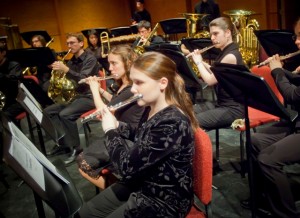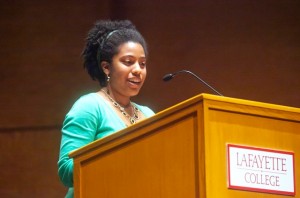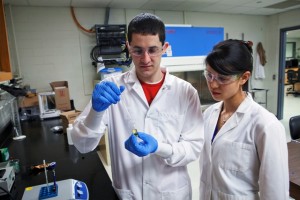With a range of interests including genetics, music, research, and working with people with developmental disorders, Mary Higgins ’15 (Annandale, N.J.) plans to use them all in her career.

Mary Higgins ’15 performs on the flute in the Concert Band.
She is well on her way after receiving a Goldwater Scholarship. A biology major and mathematics minor, Higgins wants to pursue an M.D.-Ph.D. in human genetics or a related field.
Higgins has worked with Robert Kurt, professor and head of biology, through Lafayette’s EXCEL Scholars undergraduate research program on two projects focusing on cancer patients’ immune systems and the behaviors of tumor cells. She also participated in the Summer Undergraduate Research program at Wayne State University, where she contributed to work that could be used to form better treatments for atherosclerosis and aneurisms.
At Lafayette, Higgins participates in Best Buddies, which forges friendships between college students and mentally or physically challenged individuals. She also coordinates a music therapy program at Sharing The Caring, an adult day care center.
Higgins is the epitome of a Lafayette student—talented, dedicated, hard-working, and willing to use her abilities to give back to the community. That is why she received a Marquis Scholarship from the College.

Jasmine Jay ’14 reads her poem “Two-Dimensional Jesus” during the H. MacKnight Black Poetry Reading.
Approximately 10-15 percent of admitted students each year are offered the scholarship, which provides an annual minimum award of $24,000. Also beginning this school year, Lafayette offers the Marquis Fellowship, valued at $40,000 per year, to approximately 25 admitted students each year. Those selected to be Marquis Scholars and Fellows have demonstrated intellectual curiosity, superior academic achievement, and civic engagement at their high school and hometown community.
Being a Marquis Scholar allowed English graduate Jasmine Jay ’14 to follow her passions. Jay won the College’s 20th annual H. MacKnight Black Poetry Competition with her poem “Two-Dimensional Jesus.” The competition was judged by Pulitzer Prize-winning poet Paul Muldoon.
Jay was one of 50 students nationwide to be invited to the prestigious NY State Summer Writers Institute. She received the institute’s merit scholarship and spent four weeks working with Pulitzer- and National Book award-winning writers. Jay also completed her honors project in creative writing under the guidance of Lee Upton, writer-in-residence and professor of English.
Marquis Scholar Christopher Verni ’15 (Medway, Mass.), a dual major in chemical engineering and Spanish, plans to attend graduate school for chemical engineering.

Christopher Verni ’15 works with Lindsay Soh, assistant professor of chemical and biomolecular engineering, in Acopian Engineering Center.
This summer, he learned the ins and outs of manufacturing and product development during a 12-week internship hosted by Kevin Rhodes ’82, president and founder of FMI, a contract manufacturing firm of personal care products in Bethlehem, Pa.
On campus, Verni has been working as an EXCEL Scholar with Lindsay Soh, assistant professor of chemical and biomolecular engineering, on her project to process oils, such as those extracted from corn or algae, into biodiesel using compressed carbon dioxide as a solvent. The research is funded by a $100,000 grant from the National Science Foundation, and Verni is transitioning his work on the project into his senior honors thesis.
Marquis Scholars also receive a scholarship of up to $4,000 for one faculty-led, off-campus course during an interim session in January or May.
Matthew Plishka ’15 (Moosic, Pa.), a double major in history and government & law, took the History of Japanese Culture and Government course. Led by Paul Barclay, associate professor of history, and Naoko Ikegami, visiting instructor of Japanese, the class spent two weeks traveling in Japan while learning about the country’s complex and storied history through readings, language study, participation in cultural demonstrations, and classroom lecture and discussion.
“What we were learning made it a more full experience,” says Plishka. “If you’re looking at something and you have no context of what you’re looking at, it’s hard to fully appreciate it. But if you understand the time period, why it was built, who built it, it makes it more worth seeing.”


